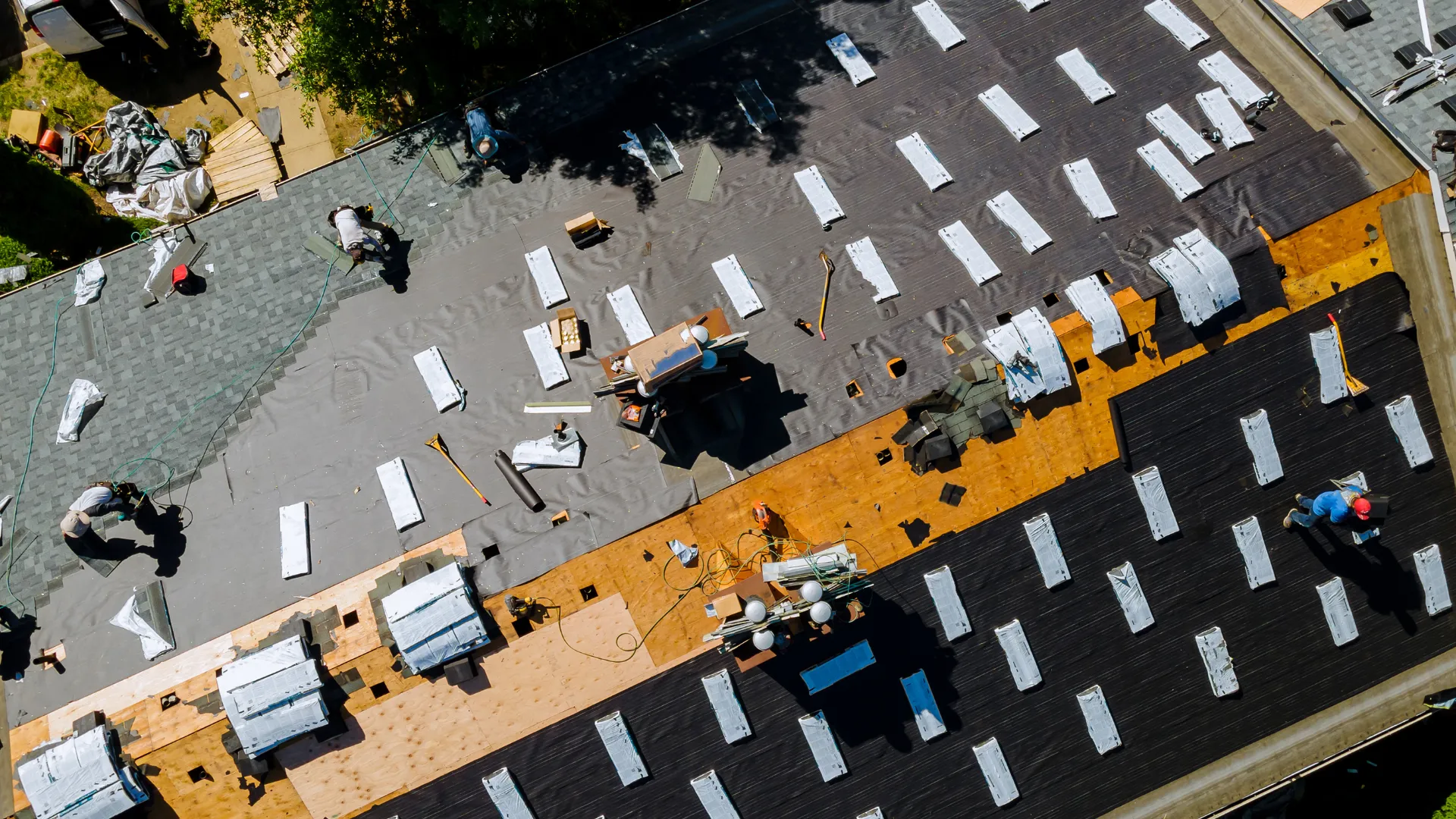For homeowners in Texas, the average cost of a new roof in Texas typically falls between $8,500 and $14,300, with a more common average around $10,000. However, the final cost can vary significantly based on the size of your roof, the materials used, and other individual project factors.
This article will break down these elements to help you understand what is the average cost of a new roof in Texas and what contributes to the overall expense of a roof replacement in Texas.
Key Takeaways
- The average cost of a new roof in Texas is around $10,000, with prices typically ranging from $8,500 to $14,300, influenced by materials, size, and design complexities.
- Roofing material choice significantly impacts costs, with asphalt shingles being the most economical option, while materials like metal and tile can be more expensive but offer greater durability.
- Homeowners should account for additional costs such as old roof removal, permits, and potential add-ons, and consider financing options like home equity loans or contractor financing to manage expenses.
Understanding the Cost of a New Roof in Texas
In Texas, when homeowners undertake a roof replacement project, they should anticipate an average expenditure of approximately $10,000. This amount may vary widely, ranging from $8,500 to $14,300 depending on the specifics of the job at hand. Costs can even escalate to about $25,000 for particularly extensive or intricate roofing tasks. Grasping the intricacies of roofing costs is vital in Texas where local climatic conditions can markedly influence both how long your roof will last and its resilience.
Roofing projects can vary in complexity and cost, significantly impacting the overall expense. The expense involved in installing a new roof hinges upon several pivotal aspects such as the choice of roofing material employed, the overall surface area covered by the roof and also factors like pitch and design which come into play during construction. A thorough examination of these components is essential to forming an accurate estimate before proceeding with any work associated with acquiring a new durable shelter overhead.
Average Costs Based on Roofing Materials
Selecting an appropriate roofing material is pivotal in determining the total expense of a roof replacement. Asphalt shingles are widely favored for their cost-effectiveness, with prices commonly ranging from $2.50 to $4 per square foot. The most affordable option within this category is basic three-tab asphalt shingles, while high-end architectural shingles may escalate up to about $6 per square foot. For a conventional 2,000-square-foot roof, the installation costs using asphalt shingles can span between $3,200 and $7,600.
Alternatively, metal roofs represent a sturdier but more expensive choice. Installing them on a similar 2,000-square-foot area might set you back anywhere from $6,000 to as much as $34,000. Metal roofing’s durability coupled with its capacity to withstand Texas’ extreme weather conditions often justifies its higher investment value. Additionally, metal roofs are known for their long-lasting and weather-resistant nature. Metal roofing is also versatile, available in different forms such as aluminum shingles and zinc tiles.
In contrast to both options above lies tile roofing—a premium selection—with slate tiles specifically costing somewhere between $12,000 and upwards of $25 thousand dollars depending on various factors including complexity when installed across identical dimensions (i.e., 2k sq ft). Similarly-priced wood shingle installations hover around the range of approximately $480-$630 per hundred square feet required by your project plan—demonstrating how different materials bring unique challenges and benefits that directly influence your final roof replacement project costs overall.
Asphalt Shingles and Other Roofing Materials
Asphalt shingles are the most popular roofing material in the United States, accounting for over 70% of all roofing installations. They are affordable, easy to install, and come in a wide range of colors and styles. However, they have a relatively short lifespan compared to other materials, typically lasting between 20 to 30 years.
Other popular roofing materials include metal roofs, which are durable and can last up to 50 years, but are more expensive than asphalt shingles. Wood shingles and shakes are also popular, offering a natural look and feel, but require more maintenance than other materials. Concrete tiles and slate tiles are also options, offering a long lifespan and durability, but are more expensive than asphalt shingles.
When choosing a roofing material, it’s essential to consider factors such as climate, budget, and personal preference. It’s also important to consult with a professional roofing contractor to determine the best material for your specific needs.
Impact of Roof Size on Cost
Roof size significantly determines roof replacement costs. Larger roofs require more materials and labor, which naturally increases the overall expense. For instance, a 1,000-square-foot roof replacement might cost anywhere from $4,000 to $40,000, whereas a 1,500-square-foot roof could range from $6,000 to 60,000, with the average roof replacement cost and roof cost being crucial factors to consider.
By multiplying the roof’s square feet by the average cost per square foot of the chosen material, homeowners can get a clear estimate and plan their budget accordingly.
Influence of Roof Pitch and Style
The complexity and materials necessary for a roof replacement are significantly impacted by the pitch of your roof, which is classified as either low, moderate, or steep. Steep roofs. Lead to greater expenses owing to their larger surface area and more complex installation requirements. They demand additional labor and resources, thus making them pricier than those with a lower slope.
Likewise, roofs with elaborate designs like hipped roofs need an increased amount of labor and materials when contrasted with simpler configurations such as gable roofs. The design intricacies coupled with the angle at which your roof slopes play pivotal roles in determining roofing costs due to their influence on installation difficulty and material needs.
Factors That Affect Roofing Costs in Texas
In Texas, the expense of roof replacement is shaped by several crucial factors that homeowners should be aware of before commencing their project. The cost can vary significantly depending on whether your home is situated in an urban or rural location, with prices typically higher in city settings. Regional building codes and climatic conditions are key elements that influence the overall roofing costs.
The availability and cost variations of different roof materials can significantly impact the overall expense of a roofing project. Specific materials may be influenced by regional preferences and economic factors, directly affecting the total cost.
Securing precise estimates for roofing expenses necessitates obtaining comprehensive bids from contractors within your vicinity. These quotations must account for a range of considerations such as workforce charges, material types utilized, and fluctuations related to different seasons. Examining these components closely will offer a clearer insight into how they contribute to the total cost.
Labor Costs
In Texas, labor costs are usually responsible for 40% to 50% of the entire cost of roof replacement, and this can fluctuate based on the area. Labor cost can vary based on factors such as location, complexity of the job, and different quotes from local contractors. Larger metropolitan areas such as Dallas or Austin often experience higher rates for labor due to greater demand and elevated living expenses. Contractors with extensive experience might command higher fees which mirror their proficiency and guarantee superior quality workmanship, affecting your budgetary allocations for a roofing project substantially.
The complexity involved in a roofing job also plays a pivotal role in dictating labor costs. Roofs that feature complex designs or possess several pitches necessitate extended time commitments and advanced skill sets from workers, thereby driving up the total replacement cost. Opting for skilled contractors may come at an increased initial investment but is likely to result in impeccable installation quality while extending the service life of your new roof.
Installation Methods
There are several installation methods for roofing materials, including:
- Nailing: This is the most common method of installation, where shingles are nailed directly to the roof deck.
- Stapling: This method is used for certain types of roofing materials, such as asphalt shingles, where staples are used instead of nails.
- Adhesive: This method is used for materials such as metal roofs, where an adhesive is applied to the roof deck to secure the material.
- Mechanical Fastening: This method is used for materials such as metal roofs, where screws or clips are used to secure the material to the roof deck.
The installation method used can affect the overall cost and quality of the roof. It’s essential to choose a reputable and experienced roofing contractor to ensure a proper installation.
Material Costs
The cost of materials plays a crucial role in the overall expense of roofing. In Texas, widely used asphalt shingles fall into an economical bracket, costing between $4 to $7 for every square foot. Conversely, high-end options like synthetic cedar shakes designed to withstand the harsh Texan weather conditions can set homeowners back about $10 to $14 per square foot.
Making an investment in premium roofing materials can be financially beneficial by diminishing the need for frequent repairs and thus providing savings over time. Selecting appropriate materials requires careful consideration of not just initial expenditure but also future upkeep and resilience.
Seasonal Variations
The expenses associated with roof replacement can vary greatly and are often influenced by the time of year. In summer, when there is a heightened demand for roofing services, you might find yourself facing increased costs. To potentially secure more favorable pricing and decrease your outlay, consider arranging your roof renovation during spring or fall, periods that typically see less demand for these services.
Additional Expenses in Roof Replacement Projects
Homeowners contemplating a roof replacement must consider not only the fundamental expenditures for materials and labor, but also additional costs that can accrue. Expenses such as those incurred from disposing of the old roofing material, securing required permits, and opting for extra features or improvements should be taken into account.
Reserving a minimum of 15% of your overall roofing budget is recommended to cover any unexpected expenses that may crop up during the process. We will delve deeper into these potential extra charges to better understand their impact on your roofing project.
Old Roof Removal Costs
Undertaking the task of a roof replacement necessitates meticulous removal and disposal of old shingles along with any base layers. In Texas, the expense associated with discarding an aged roof fluctuates between $1 to $5 for each square foot. This variation is based on the state of the decking beneath it. Expect labor charges specifically for dismantling to lie within $1 to $2 per square foot.
Consequently, these expenditures can escalate quickly. It’s imperative to incorporate such costs into your comprehensive financial plan for your roofing renewal endeavor.
Permits and Inspections
Securing the required permits and undergoing proper inspections are critical for adhering to local building codes. In the state of Texas, the price for acquiring a permit can fluctuate from $400 to $1,000 based on the specific locality. One must anticipate that an average roof inspection may cost between $100 and $600.
Ignoring these expenses could result in penalties and escalate the costs associated with replacements.
Add-Ons and Upgrades
Incorporating add-ons and enhancements into your roofing project can lead to a notable escalation in the total expenditure. Fundamental components such as underlayment and flashing are vital for augmenting the roof’s defense against elements and will contribute to the costs. Additional outlays may arise if there is a need to substitute gutters or erect a chimney.
Opting for superior upgrades like skylights or advanced ventilation systems can amplify both the practicality and visual charm of your residence, though these come with an increased financial commitment. These potential expenses should be taken into account when formulating a budget plan for your roof replacement endeavor.
DIY Roof Replacement Considerations
While it’s possible to replace a roof yourself, it’s not recommended unless you have extensive experience and knowledge of roofing. Roof replacement can be a complex and dangerous process, requiring specialized tools and equipment.
If you do decide to replace your roof yourself, make sure to:
- Follow all safety guidelines and regulations
- Use proper installation techniques and materials
- Ensure you have the necessary permits and inspections
- Consider hiring a professional to inspect and approve your work
It’s also important to note that DIY roof replacement may void your warranty and insurance coverage.
Financing Options for Roof Replacements in Texas
Securing funds for a roof replacement can seem like an intimidating endeavor. Homeowners have access to various financing avenues that can alleviate the financial burden. In Texas, typical strategies include leveraging home equity loans, utilizing Home Equity Lines of Credit (HELOCs), taking advantage of contractor provided financing plans, and pursuing insurance claims as methods to cover the costs associated with roof replacements. Gaining insight into these alternatives enables you to select the most suitable financing approach tailored to your specific situation.
To delve deeper into this subject matter, let’s scrutinize each method more closely.
Home Equity Loans and HELOCs
Homeowners can leverage the equity accrued in their homes by obtaining home equity loans, which offer a swift influx of capital, attractively low fixed interest rates, and reduced costs for borrowing. Alternatively, a HELOC provides homeowners with a flexible line of credit that draws from the value of their home’s equity over an initial period often lasting up to ten years. To qualify for these financial options one should have more than 15% equity vested in their property.
It is crucial for individuals considering this method of financing to be assured in their capacity to manage the regular payment obligations before proceeding with securing a home equity loan. This route presents an excellent opportunity to cover roof replacement expenses efficiently without imposing undue pressure on personal economic resources.
Contractor Financing Plans
Numerous roofing contractors provide financing options that assist homeowners in spreading out the expense of roof replacement. This makes acquiring a new roof more manageable without requiring substantial initial outlay, offering flexibility and ease.
Investigating the various financing solutions offered by contractors could serve as an effective approach to handling the costs associated with roofing work.
Insurance Claims
If your roof sustains damage due to extreme weather events or incidents within the scope of your insurance policy, you may be eligible for coverage on a roof replacement. It is crucial that homeowners contact their insurance company as soon as possible following any such event in order to initiate the claim procedure.
Typically, damages attributed to regular wear and tear are not covered by insurance policies. While dealing with insurance claims can be complex, successfully managing this process has the potential to greatly diminish the personal financial burden associated with replacing a roof.
Finding a Reputable Roofing Contractor in Houston, Texas
Selecting a reputable Houston roofing contractor is critical for achieving quality workmanship on your roof replacement project. Opt for those with a robust reputation and demonstrated experience, especially in executing high-end roof replacements. Recommendations from friends, family, or former clients can serve as reliable references when searching for a dependable roofing professional.
When seeking out the appropriate roofing contractor in Houston for your needs, it’s essential to bear several vital factors in mind.
Checking Credentials and Reviews
Ensuring that a roofing contractor is both licensed and insured safeguards you from potential liabilities while also confirming adherence to established industry norms. Examining the feedback from past clients will shed light on the contractor’s level of professionalism, ability to communicate effectively, and the caliber of work delivered.
By scrutinizing these qualifications, you can make a well-informed choice when selecting a roofing contractor for your needs.
Getting Multiple Quotes
It is wise to gather several estimates when planning your roofing project, as this helps guarantee that you’re receiving a reasonable rate. Strive to secure a minimum of three different proposals from various contractors in order to scrutinize the specifics and financial aspects involved.
By doing so, you can gain a more comprehensive view on the range of pricing available and pinpoint any major discrepancies between the quotes provided.
Evaluating Warranty Offers
It is essential to grasp the scope of warranties from both manufacturers and contractors for lasting contentment. Warranties from manufacturers usually address material flaws, whereas those from contractors often apply to the quality of their work. Determine if labor warranties provided by contractors can be passed on, since this has implications for your home’s potential resale value.
Scrutinize the details within warranty proposals to fully comprehend their coverage extent and duration. Being informed about these protections offers tranquility and safeguards your investment over time.
The Importance of Quality Workmanship
The longevity and efficacy of your roof are greatly dependent on superior workmanship. Properly installing roofing materials with a focus on high quality minimizes the necessity for regular maintenance and contributes to prolonging the service life of your roof.
Expert roofers are crucial in enhancing both durability and function, ensuring that your home remains well-protected. Allocating resources towards skilled installation not only results in cost savings over time, but also significantly boosts the property value of your residence.
Long-Term Savings
Committing to proficient craftsmanship when installing a roof can notably diminish the likelihood of incurring repair expenses down the line. Regular, expert maintenance can prolong your roof’s durability, which ultimately curtails potential repair fees and leads to financial savings.
Ensuring top-notch workmanship guarantees that your roof will endure over time and remain resilient against severe weather conditions.
Enhancing Property Value
A professionally installed roof significantly enhances the market value and aesthetic appeal of your property. Homes boasting a high-quality or existing roof tend to draw in potential buyers more effectively, thereby making it a valuable investment.
Improving your home with quality roofing can markedly boost its appeal in the marketplace, which secures a favorable return on investment for homeowners.
Partner With Sienna Roofing
Sienna Roofing is a premier authority on roof replacements in the Houston, Texas area, with over a decade of experience. They offer a range of services, including thorough roof inspections, consistent maintenance, and responsive emergency aid.
With a commitment to uncompromising quality and client satisfaction, Sienna Roofing ensures that your roofing project is handled with the utmost care and expertise. Partner with them for a seamless and reliable roofing experience.
Tailoring roofing solutions to meet individual preferences is what Sienna Roofing excels in—each project imbued with a distinct personal flair. For those interested in obtaining a free estimate, you can reach out by dialing (832) 564-3322or by visiting them at their office location: 2400 Central Parkway Suite J, Houston, TX 77092.
Summary
The expense associated with installing a new roof in Texas is influenced by multiple aspects, including the choice of materials, labor charges, and the dimensions and design of your roof. The overall cost can rise substantially once you factor in extraneous costs such as removing the old roofing material, obtaining necessary permits, and any additional features or services.
It’s vital to consider financing alternatives and meticulously select a dependable contractor to guarantee that your roofing project proceeds without complications. Opting for superior workmanship not only leads to prolonged durability, but also increases the value of your home. When partnering with Sienna Roofing for this undertaking, you can rest assured about both quality and reliability when it comes to your new roof installation.




